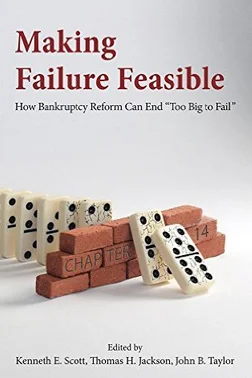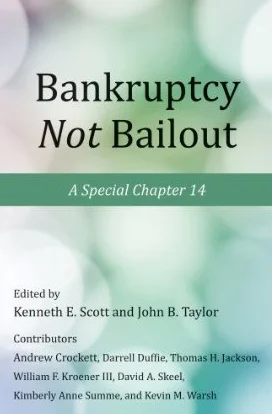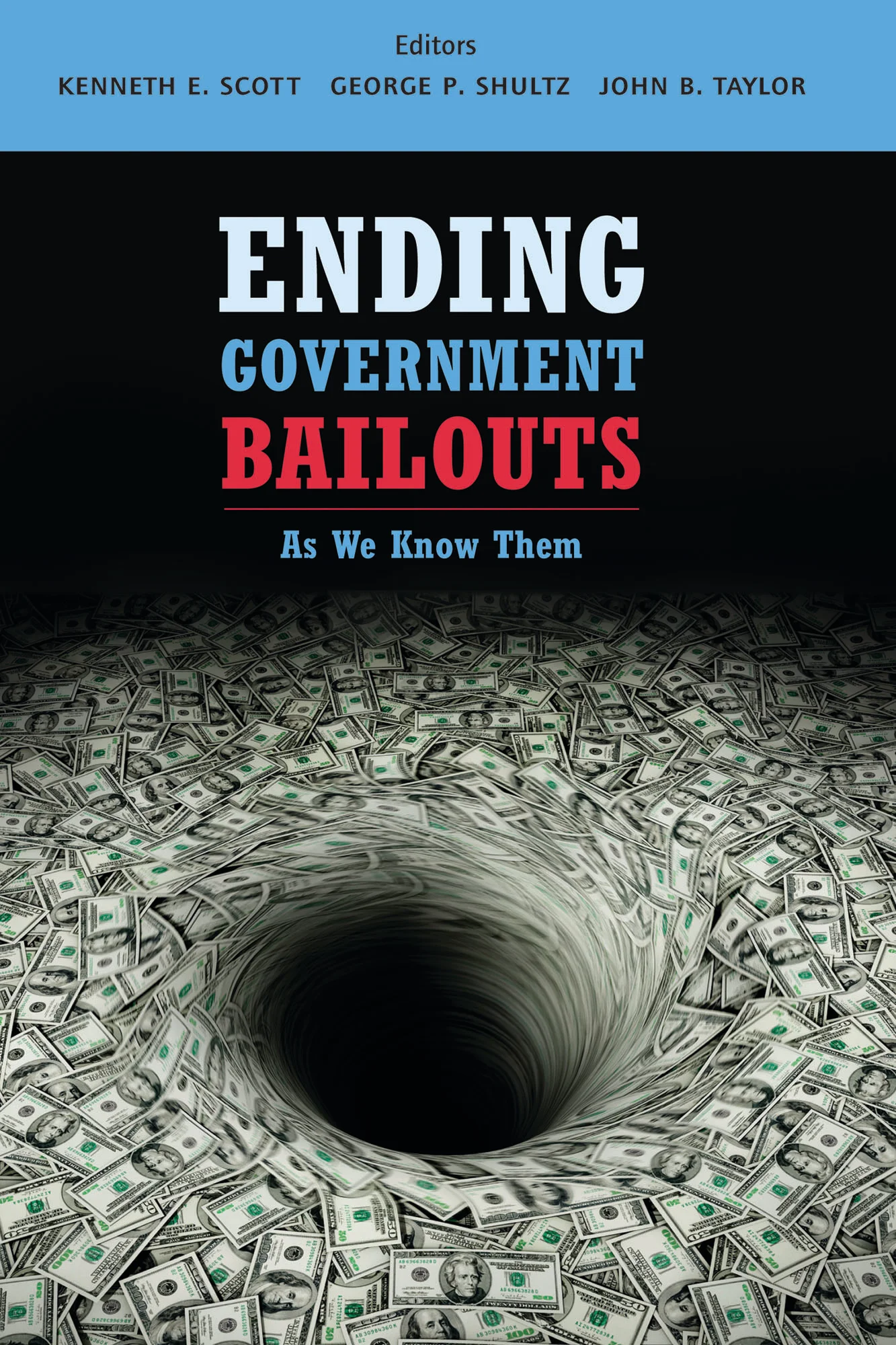MEMBERS
Darrell Duffie
Simon Gleeson
Richard J. Herring
Tom Huertas
Thomas Jackson
Emily C. Kapur
William F. Kroener III
Kenneth E. Scott
George P. Shultz
David Skeel
Kimberly Anne Summe
John B. Taylor
RESOLUTION PROJECT PUBLICATIONS
Articles and Papers
-
 The Context for Bankruptcy Resolutions by Ken Scott, July 9, 2014
The Context for Bankruptcy Resolutions by Ken Scott, July 9, 2014
-
 Building on Bankruptcy: A Revised Chapter 14 Proposal for the Recapitalization, Reorganization, or Liquidation of Large Financial Insitutions by Tom Jackson, July 9, 2014.
Building on Bankruptcy: A Revised Chapter 14 Proposal for the Recapitalization, Reorganization, or Liquidation of Large Financial Insitutions by Tom Jackson, July 9, 2014.
-
 A Guide to the Resolution of Failed Financial Institutions: Dodd-Frank Title II and Proposed Chapter 14 by Ken Scott, February 29, 2012
A Guide to the Resolution of Failed Financial Institutions: Dodd-Frank Title II and Proposed Chapter 14 by Ken Scott, February 29, 2012
-
 Bankruptcy Code Chapter 14: A Proposal by Tom Jackson, February 28, 2012
Bankruptcy Code Chapter 14: A Proposal by Tom Jackson, February 28, 2012
This paper describes several proposed changes to the Bankruptcy Code that are designed for—and limited to—the reorganization or liquidation of the nation’s largest financial institutions. The proposed changes create a new Chapter 14 of the Bankruptcy Code and incorporate features of liquidations under Chapter 7 as well as reorganizations under Chapter 11. In addition, the proposed Chapter 14 contains a number of substantive and procedural changes designed especially for the complexity, and potential systemic consequences, of the failure of these large financial institutions. Through these changes, we believe it is possible to take advantage of a judicial proceeding—including explicit rules, designated in advance and honed through published judicial precedent, with appeals challenging the application of those rules, public proceedings, and transparency—in such a way as to minimize the felt necessity to use the alternative government agency resolution process recently enacted as a part of the Dodd Frank Wall Street Reform and Consumer Protection Act. The new chapter could be adopted either in addition or as an alternative to the new resolution regime of Dodd Frank.
-
 An Examination of Lehman Brothers’ Derivatives Portfolio Post-Bankruptcy and Whether Dodd-Frank Would Have Made Any Difference by Kimberly Summe, April 2011
An Examination of Lehman Brothers’ Derivatives Portfolio Post-Bankruptcy and Whether Dodd-Frank Would Have Made Any Difference by Kimberly Summe, April 2011
-
 Dodd-Frank: Resolution or Expropriation? by Ken Scott, February 29, 2012
Dodd-Frank: Resolution or Expropriation? by Ken Scott, February 29, 2012
Much of the impetus for the financial reform legislation came from the view, correct or not, that when Lehman Brothers failed and had to go into bankruptcy, disaster ensued because it could not be taken over like a failed bank. Therefore, the Dodd-Frank Act in Title II created a new procedure (“Orderly Liquidation Authority”) to seize even nonbank financial companies whose default would, in the view of the Secretary of the Treasury, have serious adverse effects on financial stability. This procedure gives unprecedented power and discretion to an administrative official, going far beyond banking law to the point of posing serious Constitutional problems.
-
 Banking on the FDIC (Resolution Authority I) The New Financial Deal: Understanding the Dodd-Frank Act and its (Unintended) Consequences by David Skeel, 2011
Banking on the FDIC (Resolution Authority I) The New Financial Deal: Understanding the Dodd-Frank Act and its (Unintended) Consequences by David Skeel, 2011
-
 Bailouts, Bankruptcy, or Better? (Resolution Authority II) from The New Financial Deal: Understanding the Dodd-Frank Act and its (Unintended) Consequences by David Skeel, 2011
Bailouts, Bankruptcy, or Better? (Resolution Authority II) from The New Financial Deal: Understanding the Dodd-Frank Act and its (Unintended) Consequences by David Skeel, 2011
-
 Credible Resolution Policy Is Crucial for the Effective Regulation of Systemically Important Financial Institutions (SIFIs) by Richard Herring, 2011
Credible Resolution Policy Is Crucial for the Effective Regulation of Systemically Important Financial Institutions (SIFIs) by Richard Herring, 2011
-
 Transaction Consistency and the New Finance in Bankruptcy by David Skeel and Thomas Jackson, February 2011
Transaction Consistency and the New Finance in Bankruptcy by David Skeel and Thomas Jackson, February 2011
Books
-
Making Failure Feasible: How Bankruptcy Reform Can End “Too Big To Fail" edited by Ken Scott, Thomas Jackson, and John B. Taylor, September 2015
-
Bankruptcy Not Bailout: A Special Chapter 14 edited by Ken Scott and John Taylor, September 17, 2012
-
Ending Government Bailouts As We Know Them edited by Ken Scott, George Shultz, and John Taylor, March 15, 2010
-
How Big Banks Fail and What to Do about It by Darrell Duffie, November 2010
-
Resolution of Failed Financial Institutions: Orderly Liquidation Authority and a New Chapter 14, Studies by the Resolution Project at Stanford University’s Hoover Institution Working Group on Economic Policy. By Thomas H. Jackson, Kenneth E. Scott, Kimberly Anne Summe, and John B. Taylor
Resolution Project related materials
-
Implementing the Dodd-Frank Act: The Federal Reserve Board's Role. The Federal Reserve Board is responsible for implementing numerous provisions of the Dodd-Frank Wall Street Reform and Consumer Protection Act (the Dodd-Frank Act or DFA), sometimes in conjunction with other government agencies.
-
Resolution of Financial Companies Bankruptcy Study. On July 21, 2011, the board issued a study regarding resolution of financial companies under the US Bankruptcy Code. (DFA Section 216)
-
International Bankruptcy Process Study. On July 21, 2011, the board issued a study regarding international coordination of the resolution of systemic financial companies under the US Bankruptcy Code and applicable foreign law. (DFA Section 216)
-
GAO Report to Congressional Committees, July 2011. Complex Financial Institutions and International Coordination Pose Challenges
MEETINGS
December 10, 2013
Meeting of the Resolution Project with The Clearing House on Resolution of Systemically Important Banks under an Enhanced Bankruptcy Code Cleary Gottlieb, New York, NY.
Wednesday, August 28, 2013
Meeting of the Resolution Project
Sunday, May 19, 2013
Meeting of the Resolution Project
February 9, 2013
Resolution Project Meeting with the FDIC
February 8, 2013
Resolution Project Meeting with the Bipartisan Policy Center
November 10, 2012
Resolution Project Workshop on Global Systemically Important Financial Institutions
July 25, 2012
Policy Workshop: Cross-Border Resolution Policy: Issues & Options
Joint Penn/Wharton Financial Institutions & Stanford/Hoover Resolution Project
Presenters: Kern Alexander, M.P. Azevedo, Rodgin Cohen, Darrell Duffie, Randall Guynn, Richard Herring, Tom Huertas, Eva Hüpkes, Thomas Jackson, Jan Krahnen, Harvey Miller, Roberta Romano, Daniel Ryan, David Schraa, John Simonson, David Skeel, David Wall, Peter Wallison
February 4, 2012
Meeting of the Resolution Project
September 17, 2011
Meeting of the Resolution Project
April 29, 2011
Meeting of the Resolution Project in Washington, DC at the Fed and the FDIC
April 2, 2011
Meeting of the Resolution Project
May 22, 2010
Meeting of the Resolution Project
May 8, 2010
Meeting of the Resolution Project
October 31, 2009
Meeting of the Resolution Project
September 26, 2009
Meeting of the Resolution Project
August 18, 2009
New Resolution Project Planning Meeting













